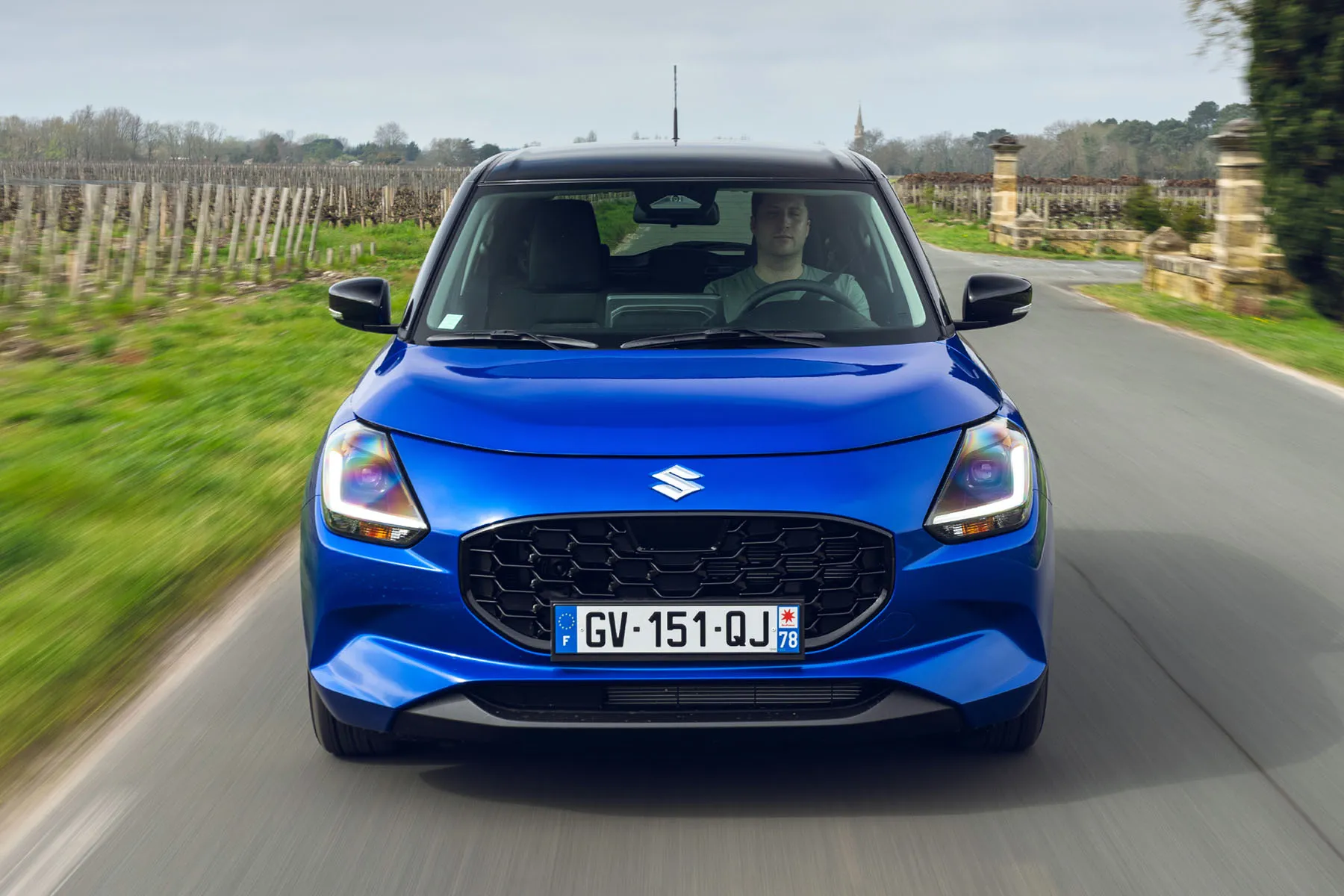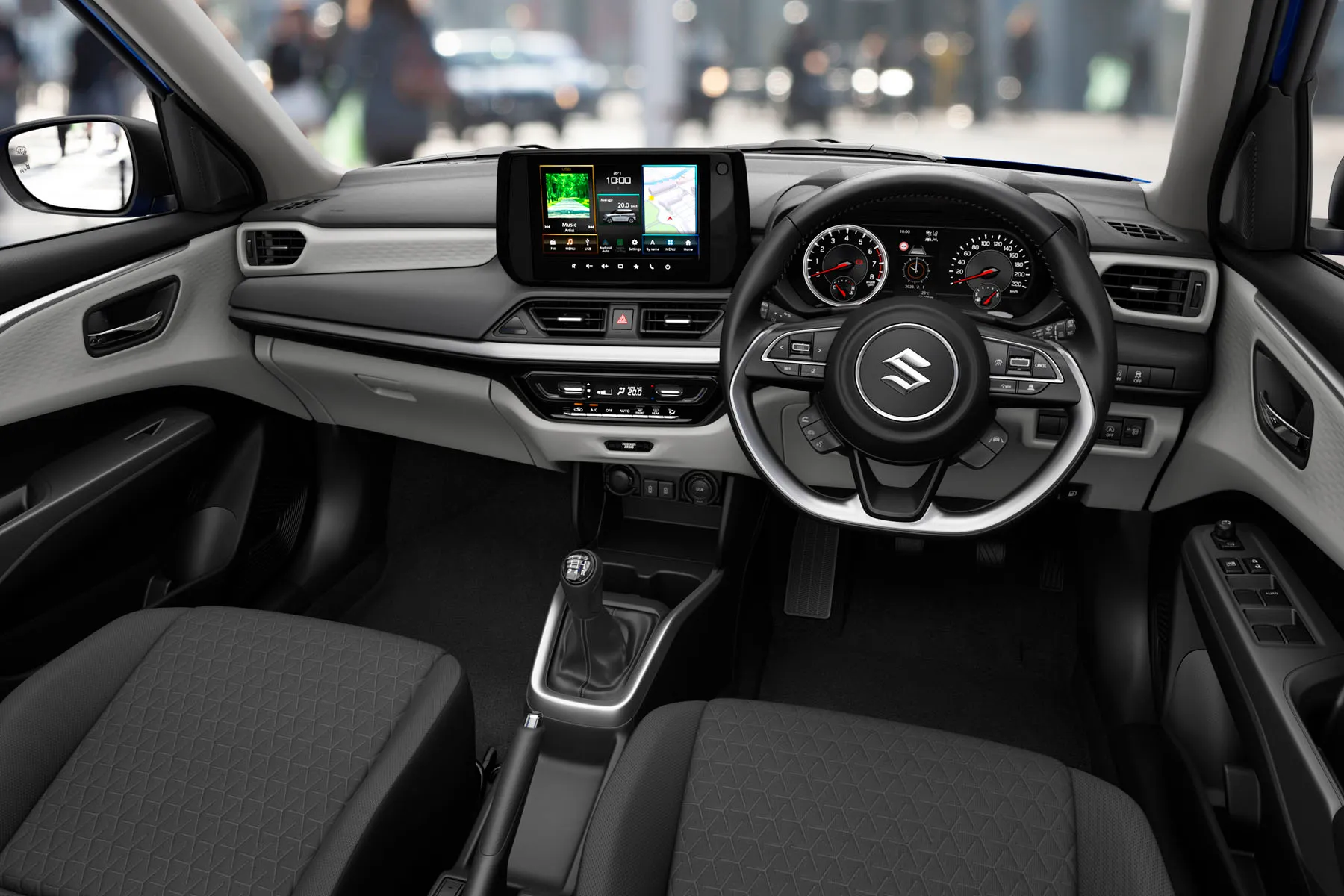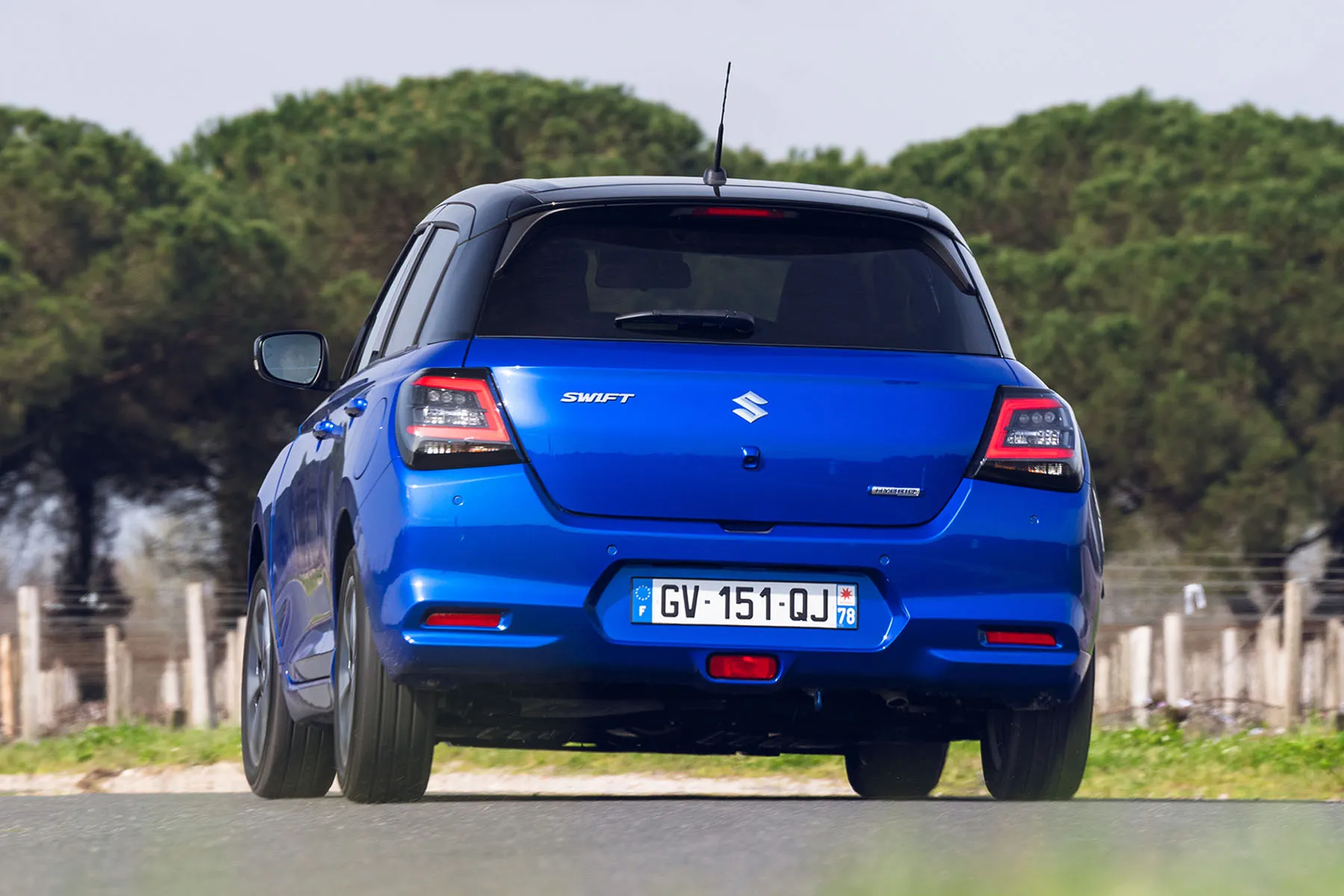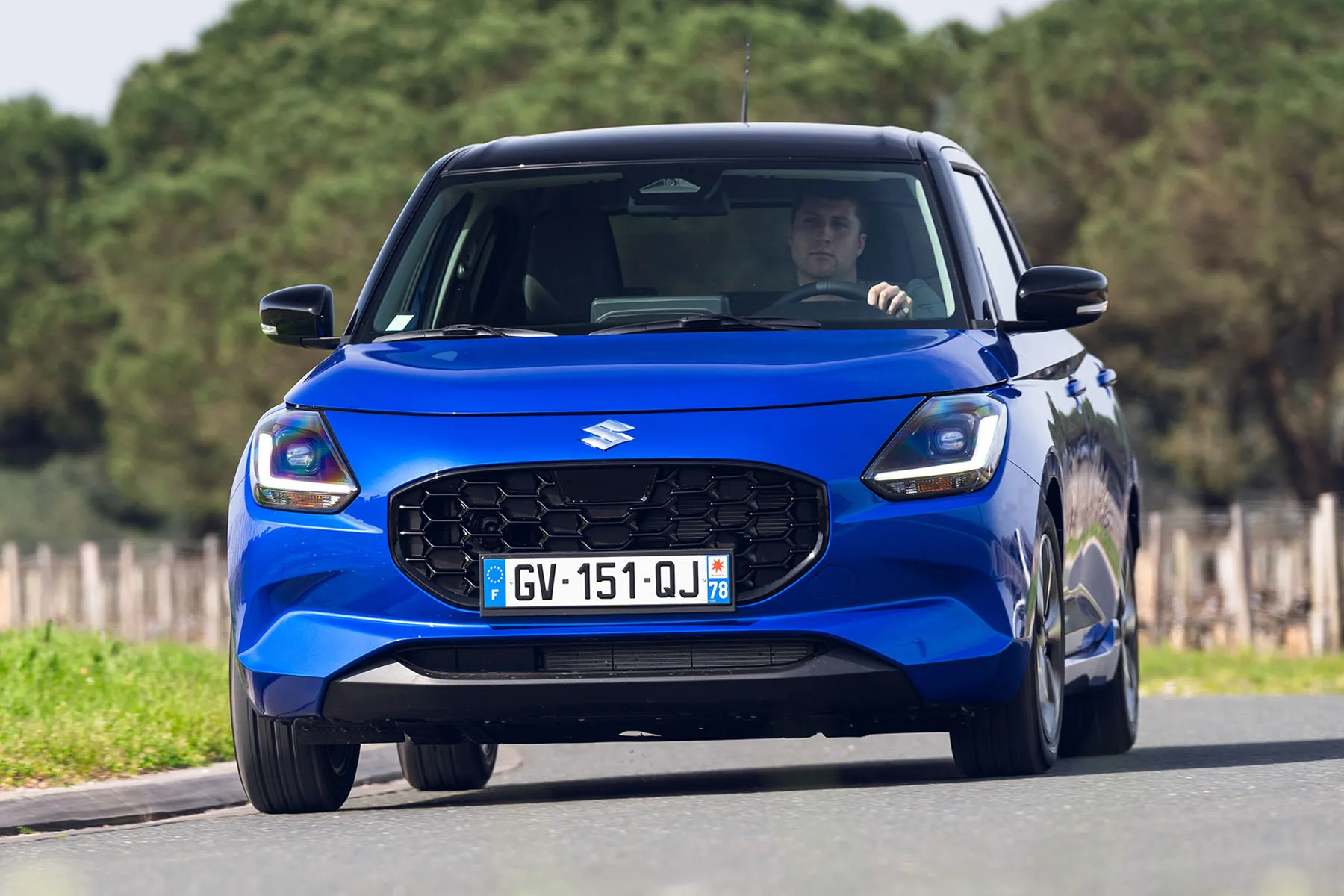Suzuki Swift Review 2025: Price, specs & boot space
Written by Andy Brady
Quick overview
Pros
- Even the most affordable model is well equipped
- Improved interior compared to its predecessor
- A sense of fun compared to other little cars
Cons
- Limited engine line-up with no 'full' hybrid or electric models
- Interior feels a bit downmarket in places
- It's smaller than most of its competitors
Overall verdict on the Suzuki Swift
"It's fair to say that too many car buyers overlook the Suzuki Swift. It's a brilliant little car with an excellent reliability record, a strong list of standard equipment and, more than anything, a sense of fun that all too many cars are missing in 2024. Combine that with a low purchase price and even lower running costs, and we reckon the new Suzuki Swift is one of the best small cars you can buy."

Suzuki reckons there are around 250,000 UK drivers who won't be able to replace their trusty little hatchback like-for-like when the time comes. That's because once-popular models like the Ford Fiesta, Nissan Micra and Kia Rio are facing the chop as manufacturers look increasingly towards more profitable SUVs and electric vehicles.
But the humble petrol hatchback still makes a lot of sense for many buyers. That's why Suzuki's continuing to offer the Swift - and, according to the brand, it could be exactly "what buyers actually want." By that we mean petrol-powered, albeit with a small amount of electrical assistance in order to give it mild-hybrid status. You can't plug it in and don't expect to drive around town with the engine off... but it's still a very efficient little car, nonetheless.
There's just one engine available... for now, anyway. That's a little 1.2-litre unit, paired with a five-speed manual gearbox or CVT automatic transmission. You can also get the Suzuki Swift with four-wheel drive, which is quite unusual in cars of this size.
Suzuki's made a conscious effort to keep the Swift's weight down. It weighs less than 1,000kg - and that's obvious in the way it drives. It's genuinely quite fun, eager to change direction and more responsive to inputs than many appliance-like small cars. It's comfortable, too, while refinement is better than you might expect for a budget-focused small car.
While Suzuki describes this Swift as an all-new car, there's clearly some carryover from the previous model. Its dimensions are almost the same - and that means it's smaller and less practical than many small hatchbacks. The interior has been heavily revamped, though, with a smart two-tone dashboard and new infotainment system bringing it up to date.
Where the new Suzuki Swift really impresses is the value for money on offer. The cheapest model starts from less than £19,000 brand new and that comes with an impressive amount of kit - including adaptive cruise control, a rear parking camera, heated seats and the nine-inch infotainment display.
Looking for a used car for sale? We've got 100s of Suzuki Approved Used Cars for Sale for you to choose from, including a wide range of Suzuki Swifts for sale. If you're looking for the older version, you need our Suzuki Swift (2017-2024) review.
Is the Suzuki Swift right for you?
If you want a characterful little car and aren't bothered about cheap electric cars, the Suzuki Swift is a great choice. It's packed with personality and comes fully loaded with equipment, while it should be very cheap to run. If you need to carry rear-seat passengers or a boot full of possessions, you may wish to consider bigger alternatives.
What’s the best Suzuki Swift model/engine to choose?
We think most buyers will be best going for the most affordable Suzuki Swift Motion. That's because it's well-equipped, and you don't get a great deal more for your money by choosing the Ultra grade (unless you really need polished alloy wheels, automatic air conditioning and an indicator integrated into the door mirror).
There's only one engine for now, and we think the five-speed manual gearbox will be the transmission to go for. Don't bother with the extra expense and complexity of the four-wheel-drive Suzuki Swift Allgrip unless you really need the extra traction - it'll make sense for a few remote farmers but it'll be overkill for the majority of buyers.
What other cars are similar to the Suzuki Swift?
There's a decreasing amount of small hatchbacks on the market. We reckon the new MG3 Hybrid will be one of the Suzuki Swift's closest competitors, while many buyers will consider it alongside a used Ford Fiesta. The Hyundai i20 is worth a look, too, as well as the Renault Clio, Vauxhall Corsa and Skoda Fabia. If you're looking for a no-nonsense small car, we'd also recommend the Dacia Sandero.
Comfort and design: Suzuki Swift interior
"It's easy to be snobby about the Suzuki Swift's cabin - it's not as plush as a Volkswagen Polo's, nor is it particularly spacious. It's got everything you could possibly want, though, while it represents a noticeable step up compared to the previous Suzuki Swift."

While the old Swift's interior was pretty drab and dark, Suzuki's taken a multicoloured approach with the new one. No, you won't find a rainbow running across the dashboard, but there are some pale grey finishes, while we also like the lighter-coloured headlining. It's not enough to distract your attention away from the hard plastic finishes but it doesn't feel any cheaper than an entry-level Hyundai i20 inside.
The front seats (heated as standard) have been redesigned with added cushioning which means the Suzuki Swift should be more comfortable for longer periods (we certainly had no complaints after a couple of hours).
The real highlight of the Suzuki Swift's cabin, though, is how easy it is to get along with. Suzuki's reluctance to follow trends goes as far as fitting easy-to-operate buttons for adjusting the climate control or skipping through tracks on your music playlist. There's even a big button on the steering wheel for turning off the (almost compulsory...) lane guidance feature.
And then there's how much you get for your money. All Swifts come with a nine-inch infotainment system angled slightly towards the driver, while a three-spoke leather steering wheel, air conditioning and keyless entry/start are all standard on even the cheapest Suzuki Swift.
Quality and finish
The Suzuki Swift is a no-nonsense little hatchback and it certainly won't impress you with its soft-touch finishes or any premium aspirations. On the plus side, the cabin is likely to be very hard-wearing - even the most well-used of secondhand Suzuki Swifts have worn their age well, and we suspect this latest model will be no different.
Infotainment: Touchscreen, USB, nav and stereo in the Suzuki Swift
The Suzuki Swift's infotainment screen has grown in size compared to its predecessor, and also moved further up the dashboard. It's now a nine-inch display perched on top of the dash (making it easy to glance at without being distracting).
To be honest, it does feel like a budget system to use. It's just a bit laggy to respond and its graphics aren't as clear as they are in rivals. But the good news is wireless Apple CarPlay and Android Auto are both standard, meaning you can connect your phone and you won't need to bother about using the car's in-built features. We prefer Google Maps to move in-car navigation systems, so that's no great issue. And, as we touched on above, there are actual buttons for most features you need - so no need to go routing through the infotainment menus.
Space and practicality: Suzuki Swift boot space
Even by small hatch standards, the Suzuki Swift isn't a big car. It measures 3860mm long, 1735mm wide and 1495mm tall - that means it's almost exactly the same size as the old Suzuki Swift and slightly smaller than a Peugeot 208 or Ford Fiesta.
It feels spacious enough for those in the front. Even with a relatively high seating position, our six-foot tester wasn't brushing the ceiling, while there's enough adjustment in the seats to get comfortable.
Things are tight in the back - like most small hatchbacks, it'll be a squeeze for two fully-grown adults, and don't even think about trying to squeeze three people side-by-side. Two child seats will fit comfortably, though, and there are ISOFIX mounting points on the outer rear seats.
The boot is pretty small. It can officially accommodate just 265 litres of luggage, which is 126 litres less than a petrol Renault Clio manages. It's fine for the weekly shop or a few weekend bags but anything more than that, you might want to look at a slightly bigger alternative.
Handling and ride quality: What is the Suzuki Swift like to drive?
"There's a sense of fun to the way the Suzuki Swift drives. It feels quite agile, thanks to direct (and communicative) steering, while it rolls less in the corners than the old model."

Driving a Suzuki Swift is just quite a pleasurable experience. The manual gear change is precise, the steering is weighty enough to inspire confidence and there's a reassuring amount of grip. You can always get the four-wheel-drive Suzuki Swift Allgrip model if you're worried about snowy winters, although that'll be overkill for most buyers.
It's easy to drive, too. The Swift's compact dimensions and decent visibility mean parking isn't a chore, while all models come with reversing sensors and even a parking camera.
Its improved dynamics don't come at the expense of comfort, either. The suspension - combined with 16-inch alloy wheels - seems to soak up bumpy road surfaces well, although we're keen to drive the new Swift on UK roads before making a final judgement on ride quality.
What engines and gearboxes are available in the Suzuki Swift?
The Suzuki Swift engine line-up is pretty simple. For now, all models come with a little 1.2-litre engine with a very small amount of electrical assistance. While it's badged a hybrid, you won't be able to run on electric power alone and alternatives like the Toyota Yaris Hybrid make a greater use of electricity.
You get the choice of a five-speed manual gearbox or a CVT automatic transmission (we haven't tried the latter but suspect the manual 'box will be the better option for most buyers). There's also a four-wheel-drive Allgrip model - that's pretty unusual at this end of the market and could be a good option if you really need the extra traction provided by all-wheel drive. We'd recommend avoiding the extra expense and complexity and sticking with the regular two-wheel-drive Swift, unless you really need to venture into muddy fields.
The Swift is, well, anything but swift. Officially it'll accelerate from a standstill to 62mph in 12.5 seconds (11.9 seconds with the CVT gearbox or 13.6 seconds with Allgrip). That's going to feel pretty slow when you're heading up a short motorway sliproad or planning an overtake.
If anything, though, we think the Suzuki Swift feels sprightlier than its figures suggest. We're keen to spend more time with it in the UK, but our initial drive in the French countryside suggested its 82PS (and 112Nm of torque) was more than enough for the lightweight hatchback. For those who do want a sportier driving experience, it's yet to be confirmed whether there'll be a Suzuki Swift Sport of this generation.
Refinement and noise levels
For a budget small car, the old Suzuki Swift surprised us in terms of refinement. Even when worked hard, the 1.2-litre engine was never particularly vocal, while outside noise (such as road and wind noise) wasn't too intrusive either.
Although we're yet to drive the new Suzuki Swift on the motorway, Suzuki says it's worked hard to improve noise and vibration levels. While we don't expect Volkswagen Polo levels of refinement, the little Suzuki Swift might be a more mature motorway car than you'd expect.
Safety equipment: How safe is the Suzuki Swift?
The Suzuki Swift has the full gammet of driver assist and safety features - from emergency braking systems to those annoying lane-assist functions; you name it, the Suzuki Swift has it. They're standard across the range, too, while even features like traffic sign recognition, reversing sensors and a reversing camera are included - not things you'd necessarily expect on an affordable small car.
Euro NCAP has yet to crash-test the new Suzuki Swift but it'll be interesting to see if it improves on the four-star (with safety pack) rating of the old car.
MPG and fuel costs: What does a Suzuki Swift cost to run?
"While the world might be going crazy for big hybrid and electric cars, the Suzuki Swift proves a small, lightweight car with only the mildest amount of electrical assistance can be very frugal."

Officially the Suzuki Swift returns 64.2mpg in official tests, while the automatic model sees 60.1mpg. Going by the old Suzuki Swift, we reckon those figures will be fairly realistic, too. HonestJohn.co.uk readers often saw more than the quoted MPG figures in the outgoing model.
How reliable is a Suzuki Swift?
If you're looking for a used car that you can have faith in, a Suzuki Swift is a pretty good choice. The little car has a reputation for being indestructible, while Suzuki ranked second (behind Lexus) in last year's HonestJohn.co.uk Satisfaction Index. We heard of no common issues with the old model and we have no reason to suspect the new car will be any less reliable.
As further reassurance, the Swift comes with Suzuki's service-activated warranty. That means it's covered for the usual three years then, after that, the warranty is automatically renewed every time the car visits a Suzuki dealer for a service. With regular servicing, you're covered for up to seven years/100,000 miles.
Insurance groups and costs
You'd expect the Suzuki Swift to be quite a cheap car to insure, but it's actually been placed into insurance group 27. That means it could cost more to insure than, say, a Vauxhall Corsa. We'd always recommend searching around for a few insurance quotes before deciding on a new car.
VED car tax: What is the annual road tax on a Suzuki Swift?
Under current VED rules, you'll pay £155/year to tax a Suzuki Swift. That's including the £10/year discount for hybrid cars.
How much should you be paying for a used Suzuki Swift?
“The new Suzuki Swift is competitively priced, starting from £18,699 for a Motion model with the manual gearbox.”

Refreshingly, we actually think the entry-level car is the one to go for - meaning you can pick up a desirable and well-equipped Suzuki Swift for less than £19,000. The CVT automatic gearbox adds a £1250 premium to the price tag, while the range tops out with the Ultra AllGrip 4wd model at £21,049.
It's worth looking at the Suzuki Swift's competitors to put its price tag into context. The cheapest Hyundai i20 you can get is nearly £21,500, while the Peugeot 208 starts from £20,400. The Vauxhall Corsa is priced from £19,625 and for that, you get a much more basic car than the entry-level Suzuki Swift.
Trim levels and standard equipment
Standard equipment on the Suzuki Swift Motion includes 16-inch painted alloy wheels, LED headlights, adaptive cruise control, a rear-view camera, rear parking sensors, navigation, heated front seats, wireless Android Auto and Apple CarPlay, keyless entry/start, Suzuki Connect connected services with three-year subscription, a nine-inch infotainment system, Lane Keeping Assist, Dual Sensor Brake Support, Lane Departure Warning & Prevention, Traffic Sign Recognition, Blind Spot Monitor and Rear Cross Traffic Alert.
The Suzuki Swift Ultra adds 16-inch polished alloy wheels, two rear assist grips, automatic air conditioning, a rear heater outlet, an indicator integrated into door mirror, electrically folding door mirrors and painted door trim ornament.
Ask the heycar experts: common questions
Is the Suzuki Swift a good car?
Is the Suzuki Swift a cheap car?
Is the Suzuki Swift a hybrid?
Get our latest advice, news and offers
Keep me updated by email with the latest advice, news and offers from heycar.
By submitting you agree to our privacy policy





